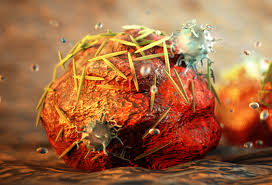Their findings could have a game-changing impact on the effectiveness of anti-cancer therapies and reducing the side effects of chemotherapy, according to the researchers. Results of their study were published recently in Proceedings of the National Academy of Sciences.
“Conventional anti-cancer drugs accumulate in the liver, lungs and spleen instead of the cancer cell site due to inefficient interactions with the cancer cell membrane,” explained Samir Mitragotri , professor of chemical engineering and Director of the Center for BioEngineering at UCSB. “We have found our strategy greatly enhances the specificity of anti-cancer drugs to cancer cells.”
To engineer these high-specificity drugs, they formed rod-shaped nanoparticles from a chemotherapeutic drug, camptothecin, and coated them with an antibody called trastuzumab that is selective for certain types of cancer cells, including breast cancer. The antibody-coated camptothecin nanorods were 10,000-fold more effective than tratsuzumab alone and 10-fold more effective than camptothecin alone at inhibiting breast cancer cell growth.
“This unique approach of engineering shapes of anti-cancer drugs and combining them with antibodies represents new direction in chemotherapy,” Mitragotri added.
Mitragotri and collaborators at UCSB, including post-doctoral researchers Sutapa Barua and Jin-Wook Yoo, and former graduate student Poornima Kolhar, looked to human breast cancer cells to examine how shape works in synergy with molecular recognition to perform complex tasks within the human body.
“We were inspired to look at the shape as a key parameter by natural objects. In nature, all key particles such as viruses, bacteria, red blood cells, platelets are non-spherical,” said Mitragotri. “Their shape plays a key role in their function.”
Their research was performed in collaboration with Yatin Gokarn and Aditya Wakankar of Genentech, a member of the Roche group. “The work of Professor Mitragotri and his collaborators exemplifies the groundbreaking contributions bioengineers at UC Santa Barbara are making in medical research, and of how our model of industry partnership delivers results,” said Rod Alferness, Dean of the College of Engineering.
The study was completed with support from Genentech, the UC Discovery Program, and the Daryl and Marguerite Errett Discovery Award in Biomedical Research.
Story Source:
The above story is reprinted from materials provided by UC Santa Barbara.





